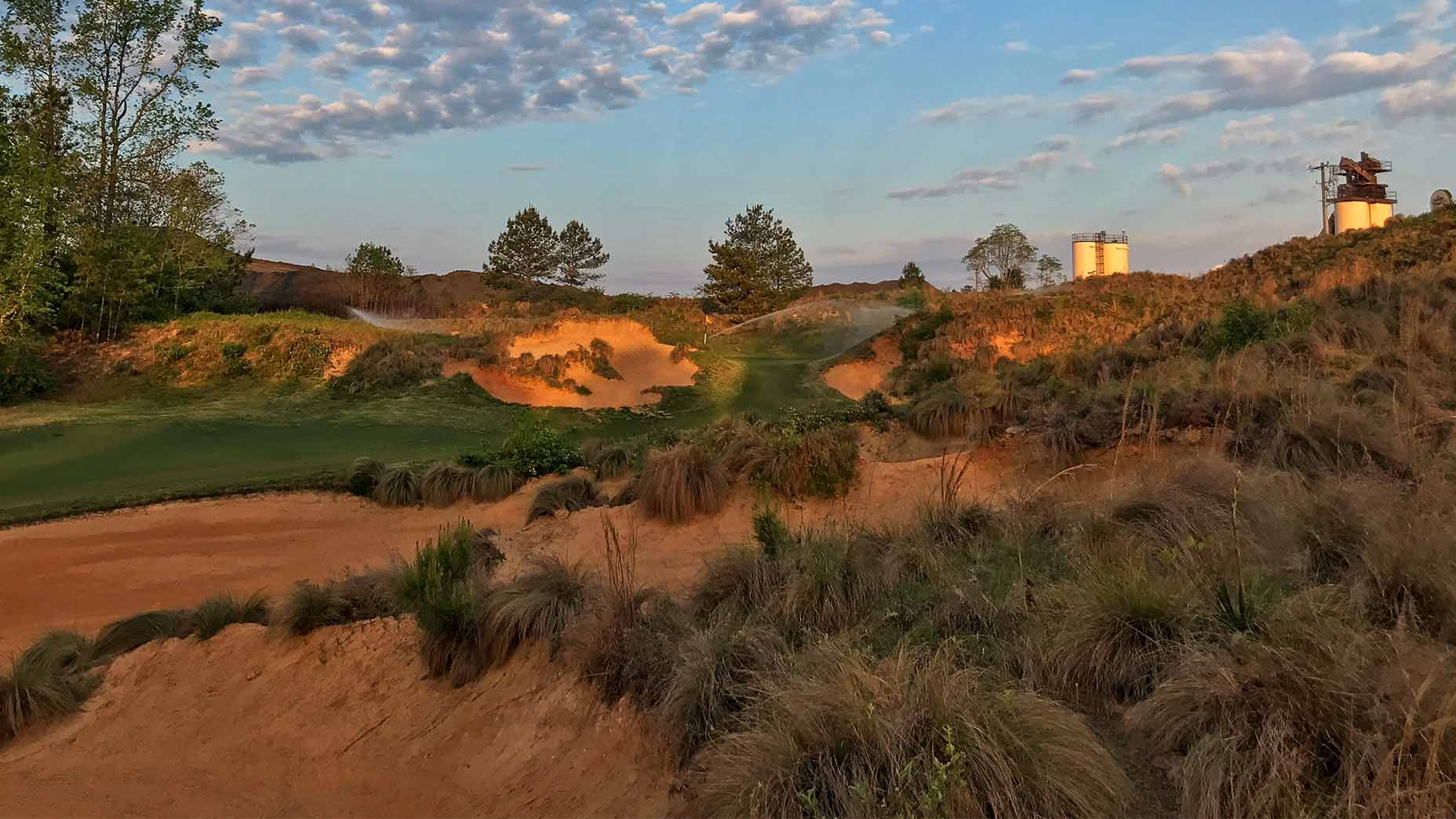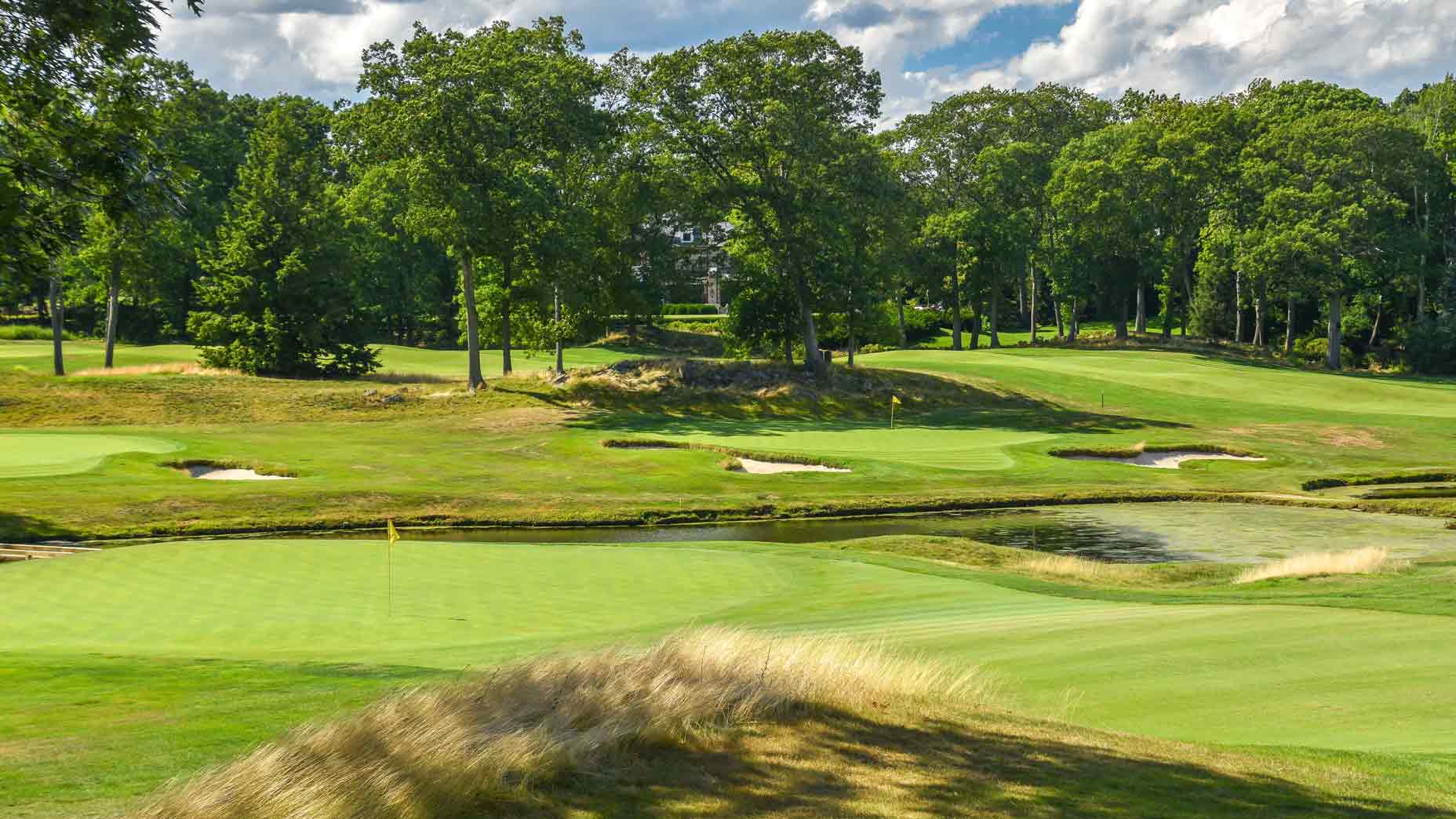Best golf courses in North Carolina, according to GOLF Magazine’s expert course raters

An overhead shot of Pinehurst Resort.
Christian Hafer
For every great course that made GOLF’s 2020-21 ranking of the Top 100 Courses in the U.S., dozens of more must-plays were left on the outside looking in — including at least a handful in your home state. Some of these designs just missed out on a Top 100 nomination, others finished deeper down the ranking, but all are worthy of your time. To shed light on the best courses in every state, we broke out the full results of our Top 100 Courses polling into state-by-state lists. Here’s a closer look at North Carolina.
North Carolina golf by the numbers:
Number of courses and U.S. rank: 533 (9)*
Number of golfers per capita rank: 24*
Average public-course greens fees: $$ out of $$$*
Average daily temp and rank: 59 (13)
Annual precipitation and rank: 50.3 in (9)
*Source: National Golf Foundation
Gear up for your next round in North Carolina
Best North Carolina golf courses (2020/2021)
1. Pinehurst No. 2 (Pinehurst, N.C.) [1, 2, 3, P]
Donald Ross’s chef d’oeuvre rolls spaciously through tall longleaf pines in the Carolina Sandhills with holes culminating with legendary inverted-saucer greens. For the 2014 U.S. Open, a Coore-Crenshaw restoration brought back the tawny-edged fairways and native areas last seen in the 1940s. Even with no rough, the runner-up could muster only one under par over four rounds. After the Women’s U.S. Open was played the following week, a powerful message had been broadcast around the world from the home of American golf about the virtues of width, short grass and great greens. This is one of a handful of courses that presents resort guests with a fun test on which they won’t lose a single ball, and a week later, can be ready to host a U.S. Open. That’s the flexibility of short grass — and Ross’s design genius.
Book a tee time at Pinehurst No. 2

2. Old Town (Winston-Salem) [1]
A brilliant course few have heard of, much less played. With wooden flagsticks, cast-iron cups, historic stone walls and a small membership, Old Town defines old-school Southern exclusivity. Perry Maxwell built this inspired North Carolina layout on a former horse farm, and the naturally rolling fairways lead to devilish greens. Wake Forest practices at Old Town, and former Demon Deacon Lanny Wadkins called it the best course for training serious young golfers. Tom Doak had another compliment for Old Town, saying it’s worth groveling to play here.
3. Wade Hampton (Cashiers) [1]
Tom Fazio has a well-established knack for building waterfalls. But at this exclusive redoubt, threaded through the folds of the Blue Ridge Mountains, he didn’t have to. Take the par-3 third hole, which plays through a valley, up a gentle rise, to a large green backed by a steep rock face where a natural cascade spills down it. It’s a setting worthy of a National Park, and one of countless photo-ready moments on a course that unspools gracefully at modest elevation, ornamented by creeks and ponds. Fazio did not forgo earth-moving altogether. But the beauty of his work here is the deference he showed to the grandeur of the land.
4. Pinehurst No. 4 (Pinehurst) [1, 3, P]
Renovating a course that rubs up against Pinehurst No. 2 is a brutal assignment because comparisons are inevitable. So, what did Gil Hanse and Jim Wagner do in 2017 when the task fell to them? First, they made sure that the course looked like it belonged on the same large swath of property as Pinehurst No. 2. A lot of work went into reconnecting the course to the ground and wiping away extraneous movement that had been added over the decades since Ross’s passing. Second, they studiously built a set of greens that in no way mimic No. 2’s but rather stand on their own, diverse merit. Pinehurst No. 4 features much more land movement than Pinehurst No. 2 and Hanse Design captured it to perfection in the stretch from 4 to 12. The home hole, with its call for a draw off the tee and a fade into the green, is a fitting conclusion and the iconic Pinehurst clubhouse in the background doesn’t hurt either.
Book a tee time at Pinehurst No. 4

5. Tobacco Road (Greenwood) [P]
Book a tee time at Tobacco Road.
6. Roaring Gap (Roaring Gap)
7. Quail Hollow (Charlotte)
8. Charlotte (Charlotte)
9. Mid Pines (Southern Pines) [3, P]
10. Dormie Club (West End)
11. Pine Needles (Southern Pines) [3, P]
Book a tee time at Pine Needles
12. Diamond Creek (Banner Elk)
13. Grandfather (Linville)
14. Eagle Point (Wilmington)
15. Forest Creek – North (Pinehurst)
16. CC North Carolina – Dogwood (Pinehurst)
17. Linville (Linville)
18. Mountaintop (Cashiers)
19. Biltmore Forest (Biltmore Forest)
20. Forest Creek – South (Pinehurst)
SYMBOL GUIDE
1 = GOLF Top 100 Course in the U.S.
2 = GOLF Top 100 Course in the World
3 = GOLF Top 100 Resort
P = Resort/public golf course
Ed. note: Some courses were omitted from our rankings because they did not receive enough votes.
Course spotlight: Grandfather (Linville), ranked 13 in North Carolina. The best mountain courses are actually those set in valleys and this is one of the best. Ellis Maples learned plenty from studying Donald Ross, and the owner, Aggie MacRae, helped him tease the best from the property. Lush mountain vegetation and low-lying rhododendrons put a premium on driving accuracy while the tilted back-to-front greens are famous for the anxiety they create — sometimes as you line up your fourth putt! The splendid valley surroundings, which includes views of Dunvagan Peak and Grandfather Mountain, act as solace. — GOLF Top 100 Course Rater

How we rank America’s best golf courses
For the newly released 2020-21 U.S. list, each panelist was provided a list of 489 courses. Beside that list of courses were 11 “buckets,” or groupings. If our panelists considered a course to be among the top three in the country, they ticked that box. If they believed the course to be among Nos. 4-10 in the U.S., they checked that box, followed by 11-25, 26-50, and so on.
Panelists were also free to write in courses that they felt should have been included on the ballot (we had fewer than a handful of such additions in the U.S. vote).
Points were assigned to each bucket; to arrive at an average score for each course, we divide its aggregate score by the number of votes. From those point tallies, the courses are then ranked accordingly. It is an intentionally simple and straightforward process. Why? Because it invariably produces results that are widely lauded. Like the game itself, there’s no need to unnecessarily overcomplicate things.
For much more on how we rate courses, click or tap here.
Meet our course raters
We empower and hold accountable a group of 97 well-traveled — and well-connected — golfers/aficionados, each capable of expressing their own sense of design excellence at the highest level. The group is seasoned and experienced — we look for raters who know what’s out there, what’s changing and what’s coming down the pike. And from judging posts across four continents, our panelists are positioned to place courses from different regions around the globe into proper context, one of the main reasons GOLF’s Top 100 Courses rankings are the most esteemed in the game.
Other ranking outlets employ thousands of raters. Our less-is-more approach creates a more meaningful and thoughtful list. Think about it: When you plan a golf trip, do you call every golfer you know for their take? No. You contact a handful of people whose opinions you value most.
Meet our full crew of panelists here.














